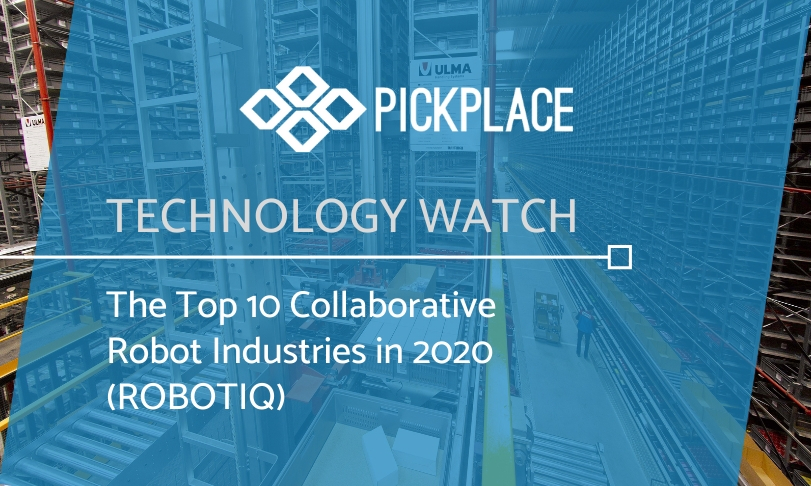Source: ROBOTIQ / by Alex Owen-Hill
Cobots are predicted to move into many industries in this new decade. Here’s our list of the top 10 industries where they will make their mark.
Cobots are nothing new, right?
If you’ve been reading this blog for a while, you’re probably already very familiar with collaborative robots (although, if this is the first Robotiq post you’re reading, welcome!!).
But, there are some industries where cobots are still pretty new. Many people in these industries still don’t know about them. We are now at the beginning of a new decade, so the number of industries which are affected by cobots is only going to rise.
There are plenty of predictions about the future of robotics being published across the web at the moment… so we’re going to do the same!
Here are the top 10 industries where collaborative robots will make a mark in the year 2020 and beyond…
1. Automotive
Sure, there’s nothing new about the use of robots in the automotive industry. The first ever industrial robot was employed in an automotive factory almost 60 years ago. However, collaborative robots are still new even within this industry.
Despite the prevalence of traditional industrial robots within automotive manufacturing, companies are only now beginning to use cobots for tasks which require a more delicate, controlled force, like sanding the paintwork of a car. As engineer Denis Kuhn from Ford said “The cobots can feel when more force needs to be applied, just like we can.”
2. Packaging
The packaging industry has been adopting cobots for the last few years, as we described back in 2018. Cobots are a good solution for taking over smaller packaging tasks which otherwise would have to be done by a human.
According to Food Processing, cobots are perfect for packaging those more delicate items, such as pre-packaged soft foods, in preparation for transport. With the right end effector, a cobot can grasp objects very gently which which is perfect for delicate handling.
3. Electronics
Electronics is an industry where cobots are beginning to be used for all sorts of applications, including assembly, inspection, dispensing, etc. One of the predictions for this industry in 2020 is that there will be more demand for “on-demand or micro-manufacturing” — in other words, high mix, low volume production.
Cobots are perfectly suited to high-mix, low-volume manufacturing because they are so easy to reprogram. Operators can switch programs at the touch of a button and even use vision sensors to learn to detect entirely new products quickly.
PCBs Quality Testing at Sennheiser USA
4. Agriculture
The agriculture industry has received a lot of attention in the robotics media over the past year. There have been various notable agriculture-related fundings in 2019 and agriculture was listed as one of the industries “where demand for robotics will continue to grow by 2025.”
There are a lot of boring, repetitious tasks within agriculture and many businesses are struggling to find enough labor to keep up. Robots of all shapes and sizes are being proposed for the industry, including using cobots to pick certain types of plant.
5. Healthcare and pharmaceutical
The healthcare industry looks set to be one of the major industries of focus over the next few years, although uptake has been very slow in the past.
The most talked about application in this industry is usually robot-assisted surgery but there are a variety of tasks which are well suited to cobots. Lab automation is a perfect example. It can be even better when done with a robot due to the reduced risk of contamination.
6. Food processing
According to Food Manufacture, cobots are “the future of food factories.” A cobot costs around the same price per day as a human worker but they can work around the clock, do not require breaks, and (most importantly) allow humans to move away from the boring tasks they don’t want to do.
Here on the Robotiq blog, we have certainly been noticing a trend for cobots in the food processing industry. Way back in 2017 we explained how robotics is affecting the entire food processing chain, from field to plate.
7. Logistics and warehousing
We said it a couple of years ago and it seems to be coming true: we are now entering the age of robotic logistics. As we’ve already mentioned above, cobots are perfect for packaging.
Picking, packing, and palletizing are all tasks that are very well suited to collaborative robots. Cobots are helping to improve efficiency in warehouses, allowing human workers to focus on the more value-added tasks.
8. Metalwork
The metalwork industry might seem a surprising place to see a cobot given that the tasks often involve harsh environments and heavy power tools. However, cobots are making their way into metal fabricators.
Although cobots can’t do the heavy duty tasks, they are great for peripheral tasks like machine tending, surface finishing, and pick and place.
9. All manufacturing
Several of the industries listed already can be classed as manufacturing. But, overall, the manufacturing sector is the one where cobots are being used over any other. According to The Robot Report, nearly 60% of manufacturers are using some kind of robotic technology already. This isn’t every single business, but it is a clear majority.
Cobots are only a subset of this but there is certainly a lot of room for the demand to grow. They have opened up a whole new set of applications and tasks to robotics which were previously impossible to automate.
10. Your industry…
Is your industry not listed above?
Even if it isn’t listed, there is a possibility that you can still use collaborative robots in 2020. Many of the most common tasks for cobots are similar across industries and there are probably some dull, dirty, or dangerous tasks which could easily be handed over to a cobot.
It looks like 2020 will be the year when cobots branch into some new and unexpected industries. Maybe your industry will be one of them!

